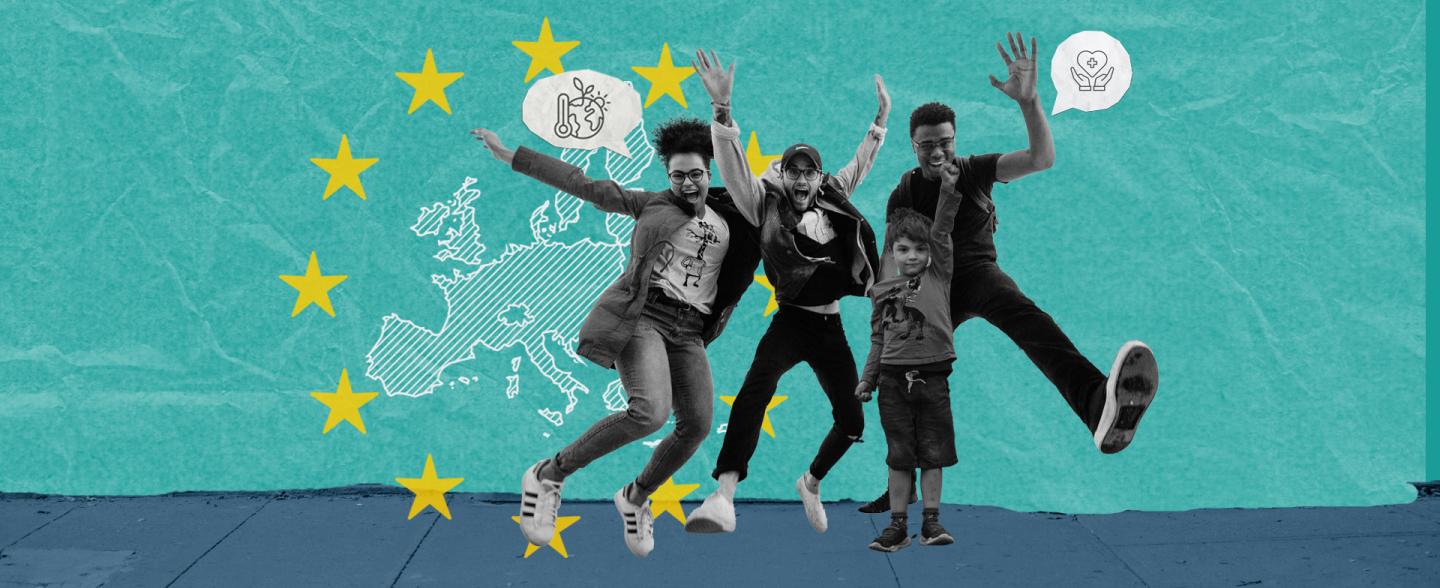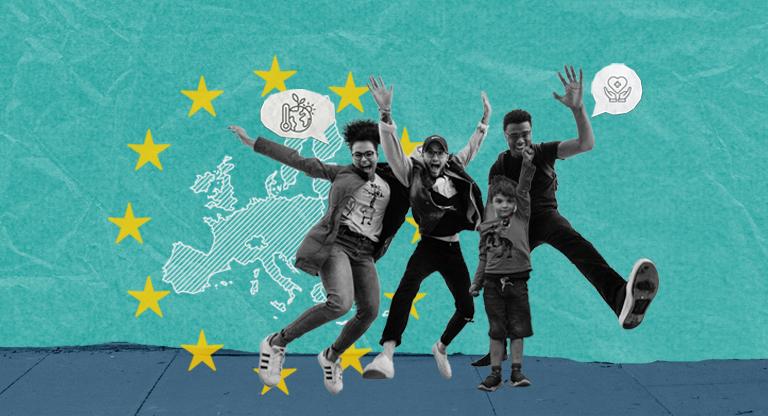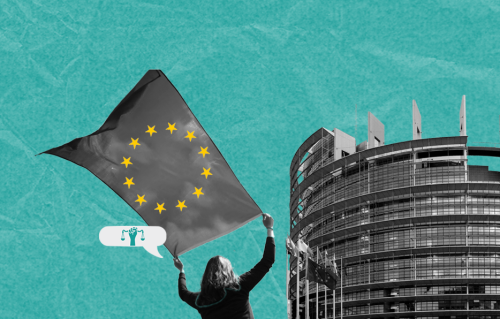The public needs to be actively involved in formulating EU policies that directly impact their lives. The following learning package will walk you through the EU participation mechanisms that are the most relevant for CSOs.
By the end of this learning package, you will:
- Be able to distinguish between the different types of EU participation mechanisms that are already available and relevant for CSOs;
- Be able to choose which of these mechanisms may be the most suitable for the advocacy actions you are considering;
- Have learnt about good practices that CSOs have successfully applied when using these mechanisms in their EU-level work;
- Have a critical view on the gaps of the existing mechanisms.
Engaging individuals and organised civil society in policy-making at the EU level is key for democratic legitimacy. As over the years the EU has recognised, it is an important step to bring decisions "closer to citizens". Following the 2001 White Paper on European Governance and the 2002 EC Principles and Minimum Standards, the right to public participation was enshrined in the Treaty of the European Union in 2009.
- Article 10 prescribes that every citizen shall have the right to participate in the democratic life of the Union, and decisions shall be taken as openly and as closely as possible to the citizen.
- From the perspective of citizens’ and CSOs’ participation the most important is Article 11, which introduces for the first time an element of obligation and a legal basis for participation.
In addition to the general rules laid out in the treaties, the Better Regulation Guidelines and Toolbox set out the principles that the European Commission follows when preparing new initiatives, and when evaluating existing legislation.
These safeguards envisage an advanced participation model with a joint obligation for EU institutions to ensure that the public is actively involved in formulating policies that directly impact their lives.
European Citizen’s Initiative (ECI): a direct way for citizens to influence the EU legislative agenda. It allows EU citizens to propose new legislation or call for changes to existing laws from the European Commission. In order to register an ECI, the organiser needs to have seven different persons living in seven different EU countries. They need to gather at least 1 million signatures from fellow citizens with minimum numbers in at least seven Member States. ECI is not binding: the Commission has full discretion in deciding whether and how to adopt a follow-up proposal. The entire procedure can be done online through the ECI platform and you can read how to do it step by step here.
Examples:
- In 2013 Right2Water became the first ECI to collect more than a million signatures, reaching over 1,8 million by the end of the campaign. It aimed to commit the EU and Member States to implement the human right to water and sanitation. The campaign involved more than 120 CSOs and was supported by German and Austrian trade unions. As a result, the European Parliament and the Council adopted the revised Drinking Water Directive, which entered into force in 2021.
- The ReclaimYourFace campaign launched an ECI in January 2021 for a ban on biometric mass surveillance practices. It collected 78,092 signatures without using any targeted social media advertisement. Instead, the campaign relied on supporters and partners sharing posts, sending newsletters, collecting signatures on the streets, or participating in the viral #PaperBagSociety challenge. While it was not able to reach the threshold of 1 million signatures, the petition still proved to be very powerful: not only did it build up a broad and diverse coalition committed to protecting fundamental rights in the digital space, it also supported national campaigns against biometric surveillance. It was also instrumental to put the issue at the core of the debate at the EU and remind policy-makers why banning biometric surveillance matters for democracy and human rights.
When is the ECI the right tool for you?
- You wish to propose a new legislation or call for changes to existing laws from the European Commission;
- The topic of your initiative enjoys a wide support of people across the EU, or you find it important to raise an issue relevant for society and the European political agenda;
- You have a core team with seven group members living in seven different EU countries;
- You are ready for a long-distance run and have the sufficient human and financial resources to invest into mobilisation and public campaign throughout a year.
What are the steps that you can consider to successfully apply this mechanism?
- Allocate the necessary human and financial resources: you will need to have a core team that has the necessary skills and capacity to organise campaigns across borders. It is necessary to secure sufficient funding to cover the staff time and costs related to the campaign.
- Know your allies: it is important to map out relevant stakeholders, including CSOs, activists, networks, businesses, donor community, and organise targeted outreach to bring them on board.
- Organise a broad campaign: you can use diverse tools and opportunities to raise public awareness and mobilise support, including social media posts, newsletters, video messages, online games and competitions, meetings and other forms of public campaigning.
- Be inclusive: it is important to reach out to diverse groups of society both in big cities and the countryside, including underrepresented groups such as youth, women, minority groups, and people with disabilities. Consider what are the best tools to include their voices- for example, games have been successful to mobilise young people more.
- Be proactive: Organise targeted meeting with relevant EU officials to explain the issues raised in your initiative in detail even before you have submitted the initiative.
What are the pitfalls you need to be aware of?
- There are strict requirements to register an initiative and it is hard to get 1 million signatures of support within 12 months.
- ECI is not binding: the Commission has full discretion in deciding whether and how to adopt a follow-up proposal. Also, the follow-up given to ‘successful’ initiatives may not be in line with organisers’ wishes and expectations.
"Have Your Say” Portal: European Commission’s official, online public consultation platform that invites people (including businesses and CSOs) to share their views on Commission initiatives at crucial stages in the legislative process. You can take part in 12-week public consultations on initiatives under preparation or give feedback on roadmaps, impact assessments or evaluations of the performance of existing EU actions.
Examples:
- European Disability Card. The public consultation was open on the portal for 12 weeks in February 2023 to ensure that the views of the general public informed the preparation process of the impact assessment and the proposal for a European Disability Card and EU Parking Card for persons with disabilities. . It received a total of 3361 replies, out of them 2526 EU citizens, 245 CSOs and 590 from all other stakeholders such as academia, businesses, governmental bodies, trade unions. The public consultation itself was part of a wider consultation effort, which also included strategic interviews, online surveys, workshops and focus groups, as well as consultations with Member States’ authorities and CSOs representing persons with disabilities. All this feedback helped fine tuning of the legislative proposal.
- Structured engagement of young people to shape EU policies. Students from the Faculty of Political Science at the University of Zagreb, Croatia, engaged in public participation through the Have Your Say portal. Led by their professor Igor Vidacak, 120 undergraduate students selected an EU initiative open for consultation and prepared their own written comments based on evidence. They delved into problem analysis, evaluated EU competencies and past efforts in the field, and mapped stakeholders affected by the proposed policy. Through this process, besides developing analytical skills, they also learned how to get involved in policy making at the EU institution level and practised all steps of commenting on the portal.
When is the "Have Your Say" Portal the right tool for you?
- There is a draft legislation or strategy proposed by the Commission and you would like to challenge it or suggest certain amendments to the text;
- The proposed topic is of the interest of your organisation and your target group;
- You already have research and analysis on the topic proposed by the legislation and want to give your input;
- You wish to submit individual opinion without being required to mobilise broader groups;
- You want to raise awareness among your members or your target group about the possibility of shaping EU policies.
What are the steps that you can consider to successfully apply this mechanism?
- Create an account/log in: First you need to create an account to log in because commenting is possible only if you are registered on the "Have Your Say" portal.
- Research well: Analyse the situation that you would like to comment on, and do all needed research, polls, and interviews that will give you proper information, data and evidence.
- Provide comments: Once logged in, you can submit comments by typing them directly into the comment box provided on the consultation page. In some cases, you have to answer specific questions or select multiple choices, while in other cases, there are more open-ended opportunities to share your opinions.
- Follow up on your submission: In some cases, you will receive a confirmation or acknowledgment that comments have been successfully submitted, but more often, the Commission does not respond individually to each comment. However, all comments are published and taken into account when analysing public feedback. Therefore, it is helpful to reach out directly to relevant EU institutions to make your opinion and voice heard.
- Use the portal even when the draft legislation has been sent to the Parliament: When the Commission proposes laws to the Parliament, you have 8 more weeks to continue commenting. All provided comments at this stage are publicly visible and will be shared with the Parliament.
- Comment on an enacted legislation: If your proposal was not considered, you can provide your feedback even after the laws are enacted, following the same procedure.
- Raise awareness of this opportunity: You can also spread the word about the importance of providing comments to draft laws and strategies. This can take place in the form of individual outreach, trainings, university projects, promotion through social media and other means.
What are the pitfalls you need to be aware of?
- Questions can be complicated and not tailor made for civil society, thus sometimes it is difficult to contribute. Therefore, it is important to discuss beforehand and prepare the final questions of the call for evidence or public consultation with a representative from the sector, to ensure that the questions are clear and can be answered by many relevant stakeholders. It is also helpful to have more open questions during consultations to provide more space for expression;
- You do not receive individual feedback on how your proposal was considered by the Commission. Feedback is essential to show that the contributions of people and civil society have been taken into consideration. In order to strengthen the accountability of participatory tools and improve their trustworthiness among users, each tool should have clear and easily accessible information on the use of input and provide feedback to those who contribute on how their information has been taken into account or not.
European Parliament's Petitions Web Portal: it is an online platform that allows citizens, residents, and organisations from EU Member States to submit petitions to the European Parliament (EP). The primary purpose of the portal is to provide a direct link between EU citizens and the EP, enabling them to exercise their right to petition. Petitions can address a wide range of topics, such as environmental issues, human rights, consumer protection, regional development, and more. They may present an individual request, a complaint or an observation concerning the application of EU law or an appeal to the EP to adopt a position on a specific matter. Such petitions give the EP the opportunity to call attention to any infringement of a European citizen’s rights by a Member State or local authorities, or other institutions.
It is considered the oldest mechanism for public participation in the EU, and if implemented correctly, it could be the key mechanism in solving everyday EU citizens' problems.
Example:
- Petition No 0158/2023 by Emilio De Capitani (Italian), signed by seven NGOs and eleven citizens, on the initiatives by the European Parliament to strengthen the principle of legislative transparency. According to the petitioners citizens should be able to follow the decision-making process and have access to preparatory legislative documents discussed in the three EU institutions. This is not yet the case for thousands of documents exchanged in Council working groups and in the interinstitutional negotiation meetings (trilogues). The petition calls on the European Parliament to publish in its register the draft agendas of the trilogue meetings, the documents exchanged during the meetings as well as the outcome of proceedings of each meeting. Finally, the petitioners call on the European Parliament to set up a 'participatory legislative platform’ to make it easier for citizens to access legislative information, exchange views and submit suggestions during the legislative procedures.
When is the European Parliament Petition Web Portal the right tool for you?
- You need to communicate directly with the Parliament and its members to express your opinion on an issue that falls within the European Union’s fields of activity.
- You want to propose a petition, especially in the fields of focus of the Petition Committee, such as: fundamental rights (including children’s rights, discrimination, the rights of minorities, justice, free movement), the environment and animal welfare, the internal market, social rights, migration, trade agreements and public health, the protection of the rights of persons with disabilities, etc.
- You want to address issues that other institutions have not considered or have remained unresolved, as well as proposals for which other tools and mechanisms are not suitable.
- You want to have an opportunity to check the status of your petition and to have a clear (individual) feedback on your proposal.
What are the steps that you can consider to successfully apply this mechanism?
- Eligibility: To submit a petition, you must be a citizen of an EU Member State, a resident of an EU Member State, or an organisation with its headquarters in an EU Member State.
- Create an account: You must create an account on the portal and provide details about the petition, including the subject matter, the problem identified, and the desired outcome.
- Prepare an evidence-based petition: Prepare a clear and concise petition based on evidence. Thus you can increase the chances of its admissibility and relevance, whether it falls within the scope of the European Union's activities.
- Be prepared for interaction with the Petition Committee: If you receive an acknowledgement of receipt, and if the petition is admissible, you may be invited to present the petition to the Petitions Committee.
- Have your supporters: Make your petition as visible as possible and raise awareness among your partners and other interested stakeholders who can support and sign your petition, or can upgrade the evidence related to the petition matter.
- Always be ready with more information and evidence: You can be requested by the Committee for additional information and may need to attend the organised hearing on that particular petition.
What are the pitfalls you need to be aware of?
- There is a lack of interest and prioritisation of petitioning as a method for public participation by EU institutions, including MPs.
- The Petitions Committee is a body without legislative power; thus, its petitions are not the focus of the EP’s discussions. Also, the Member States rarely collaborate on the matters raised through petitions. Generally, there is a low political will and resources to consider every petition.
Research: New Dimensions for Public Participation
Would you like to learn how new tech developments (digital platforms and serious games) are used to foster participation? What could EU institutions, governments, CSOs, companies and academia do to enable more dialogue and meaningful participation? Read more in our research on these topics.
Reflect on what you have learnt:
- Are there any initiatives you are currently working on that could benefit from one of the mechanisms? Which mechanism would serve your advocacy goal the most?
- Which capacities/resources would you need to elevate in your organisation to meaningfully participate in these EU mechanisms?
- Which are some other shortcomings of the mechanisms not mentioned in the learning package that you would highlight? Could there be ways to address these?
- What are the ways to make contribution to EU-level decision-making more inclusive and how can you best advocate for these changes?
This learning package was prepared within the framework of the ParticipatiON Project, funded by the European Union. Views and opinions expressed in this material are however those of ECNL only and do not necessarily reflect those of the European Union or European Education and Culture Executive Agency (EACEA). Neither the European Union nor the granting authority can be held responsible for them.







